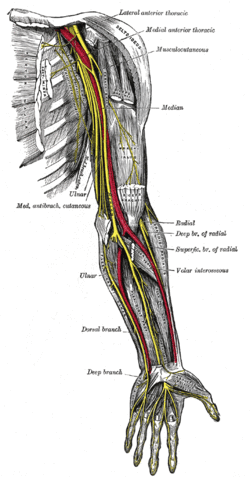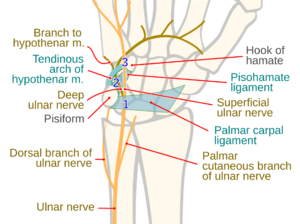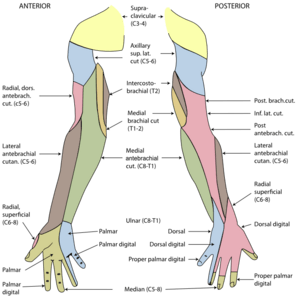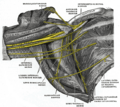Ulnar nerve facts for kids
Quick facts for kids Ulnar nerve |
|
|---|---|
 |
|
| Click image to enlarge - ulnar nerve is visible in lower left | |
 |
|
| Nerves of the left upper extremity. (Ulnar labeled at center left.) | |
| Latin | nervus ulnaris |
In human anatomy, the ulnar nerve is an important nerve that runs close to your ulna bone in your forearm. It's special because it's the largest nerve in your body that isn't protected by a lot of muscle or bone. This means it can get hurt more easily.
This nerve is directly connected to your little finger and the half of your ring finger next to it. It helps you feel things on the front and back of these fingers, even up to your fingernails.
Have you ever hit your elbow and felt a tingly, electric shock feeling? That's your "funny bone"! This happens when you bump the ulnar nerve where it passes behind a bony part of your elbow called the medial epicondyle of the humerus. The nerve is right under your skin there, so it's easy to hit. People call it the "funny bone" because the upper arm bone is called the humerus, which sounds like "humorous" (meaning funny).
Contents
What is the Ulnar Nerve?
The ulnar nerve is like an electrical cable that sends messages between your brain and parts of your arm and hand. It helps you move certain muscles and feel sensations.
Where is the Ulnar Nerve Located?
The ulnar nerve starts from nerves in your neck (C8 and T1). It then travels down your arm.
In the Arm
In your upper arm, the ulnar nerve runs along the inside. It then goes behind the bony bump on the inside of your elbow. This spot is called the cubital tunnel, and you can often feel the nerve there.
In the Forearm
After your elbow, the ulnar nerve enters your forearm. It runs between two important muscles that help you bend your fingers. As it gets closer to your wrist, it goes under a strong band of tissue to enter your hand.
In the forearm, the ulnar nerve sends out smaller branches:
- Muscle branches: These help control muscles that bend your wrist and some of your fingers.
- Palm branch: This branch gives feeling to the skin on the fleshy part of your hand below your little finger.
- Back of hand branch: This branch gives feeling to the skin on the back of your hand, near your little finger and ring finger.
- Elbow branches: These go to your elbow joint.
In the Hand
The ulnar nerve enters your hand through a small tunnel called Guyon's canal. Once in the hand, it splits into more branches:
- Superficial branch: This branch helps a small muscle in your palm and gives feeling to your little finger and half of your ring finger.
- Deep branch: This branch is very important for hand movement. It controls many small muscles in your hand, including those that help you spread and bring your fingers together. It also helps you move your thumb.
- Wrist branches: These go to your wrist joint.
What Does the Ulnar Nerve Do?
The ulnar nerve is sometimes called the "musician's nerve" because it helps with the small, precise movements of your fingers.
Feeling (Sensory Function)
The ulnar nerve helps you feel things in your little finger and the inner half of your ring finger. It also helps you feel the corresponding part of your palm.
- The palmar branch gives feeling to the front skin and nails of these fingers.
- The dorsal cutaneous branch gives feeling to the back of your hand and the back of these fingers.
Movement (Motor Function)
The ulnar nerve and its branches control many muscles in your forearm and hand, allowing you to move your fingers and wrist.
- It helps control the muscle that bends your wrist (the Flexor carpi ulnaris).
- It controls half of the muscle that bends your deep finger joints (the Flexor digitorum profundus).
- In your hand, it controls muscles that:
* Move your little finger (like Opponens digiti minimi, Abductor digiti minimi, and Flexor digiti minimi brevis). * Help bend your fingers (the 3rd and 4th lumbrical muscles). * Spread your fingers apart (the dorsal interossei). * Bring your fingers together (the Palmar interossei). * Move your thumb (the Adductor Pollicis and deep head of Flexor pollicis brevis). * Help with the small muscle in your palm (the Palmaris brevis).
Ulnar Nerve Problems
The ulnar nerve can get injured anywhere along its path. It's one of the most common nerves to be hurt around the elbow. Injuries can happen from accidents or when the nerve gets squeezed or "pinched." When the ulnar nerve is injured, it can cause problems with movement and feeling.
Injuries at the Elbow
- How it happens: This often occurs from something called Cubital tunnel syndrome, where the nerve gets squeezed in the cubital tunnel at the elbow. It can also happen from elbow fractures.
- What you might notice (movement): You might have weakness when bending your hand at the wrist, or trouble bending your little and ring fingers. It might also be hard to cross your fingers.
- What you might notice (feeling): You might feel numbness, tingling, or a "pins and needles" sensation in the little finger, half of the ring finger, and the corresponding part of your palm.
- Hand shape: Sometimes, the hand can develop a "claw hand" shape. This is when the little and ring fingers look bent at the middle joints and straight at the end joints.
- Thumb weakness: You might also have weakness when trying to bring your thumb towards your palm. A doctor can check this with a test called Froment's sign.
Injuries at the Wrist
- How it happens: This can be caused by cuts, or by cysts or other growths in Guyon's canal at the wrist.
- What you might notice (movement): Similar to elbow injuries, you might have trouble bending your little and ring fingers, and difficulty crossing your fingers.
- Hand shape: The "claw hand" might look even more noticeable with wrist injuries. This is because some muscles that help bend the fingers are still working, making the fingers curl more.
- Thumb weakness: Weakness in bringing the thumb towards the palm can also be present.
- What you might notice (feeling): You might feel numbness or tingling in the little finger, half of the ring finger, and the palm side of your hand. However, the back of your hand usually still has feeling, because the branch that gives feeling to the back of the hand splits off higher up in the forearm.
In some serious cases, surgery might be needed to move the nerve or release it from pressure to prevent more damage.
Additional images
See also
- Axillary nerve
- Median nerve
- Musculocutaneous nerve
- Radial nerve














